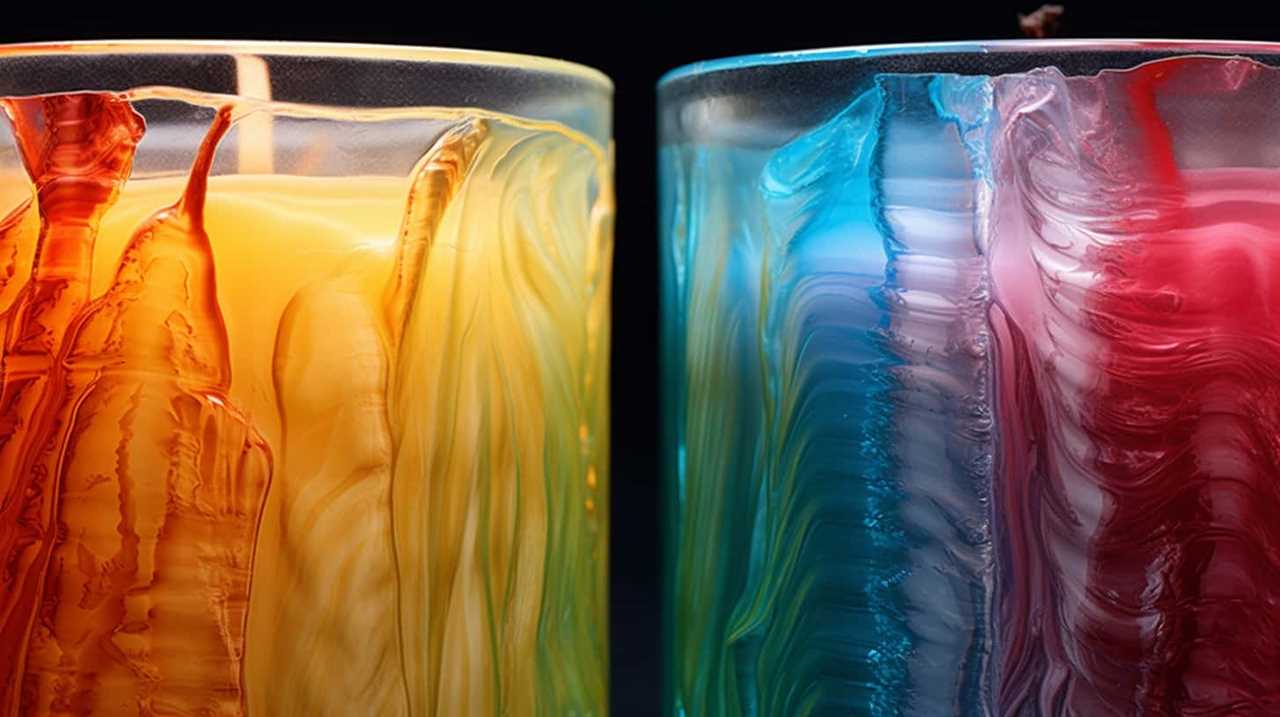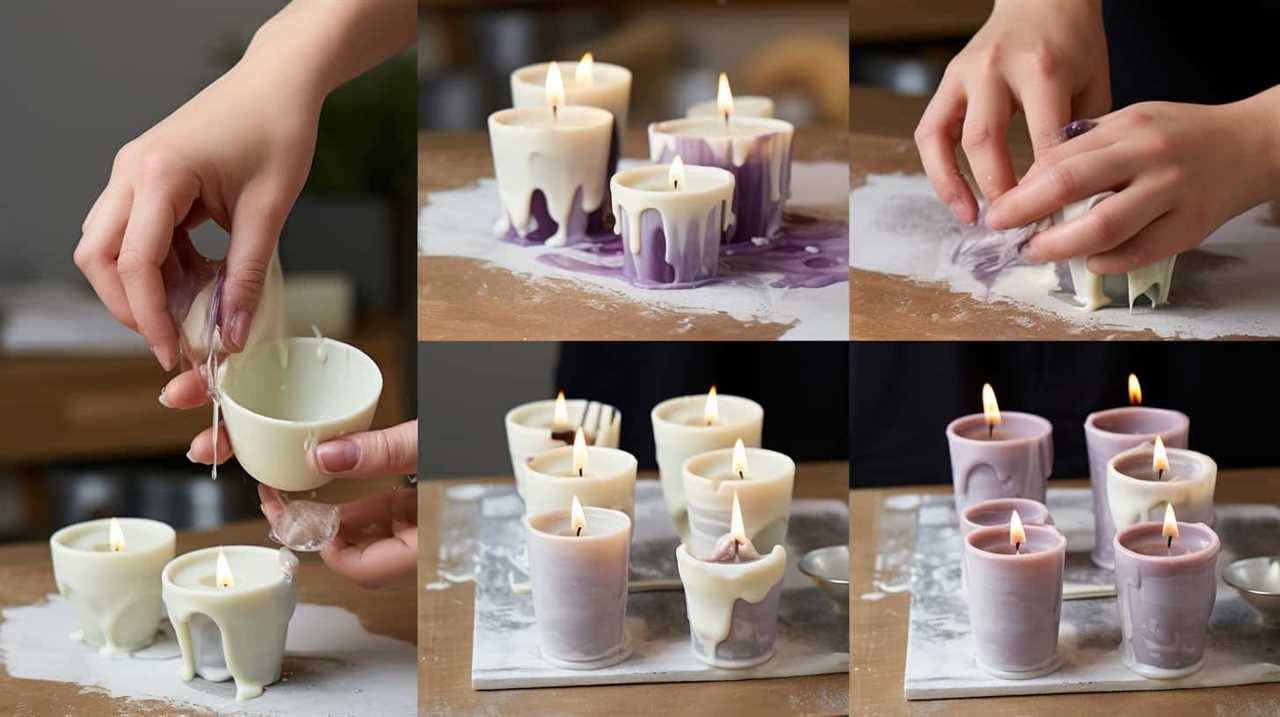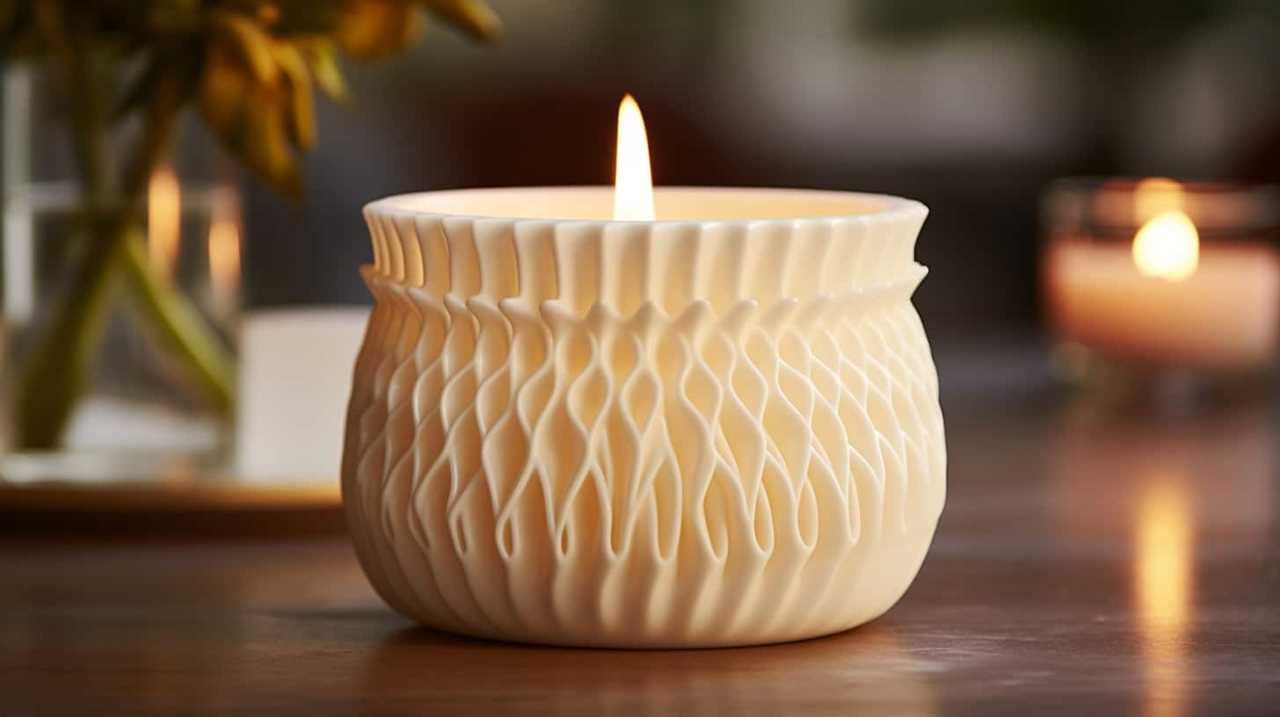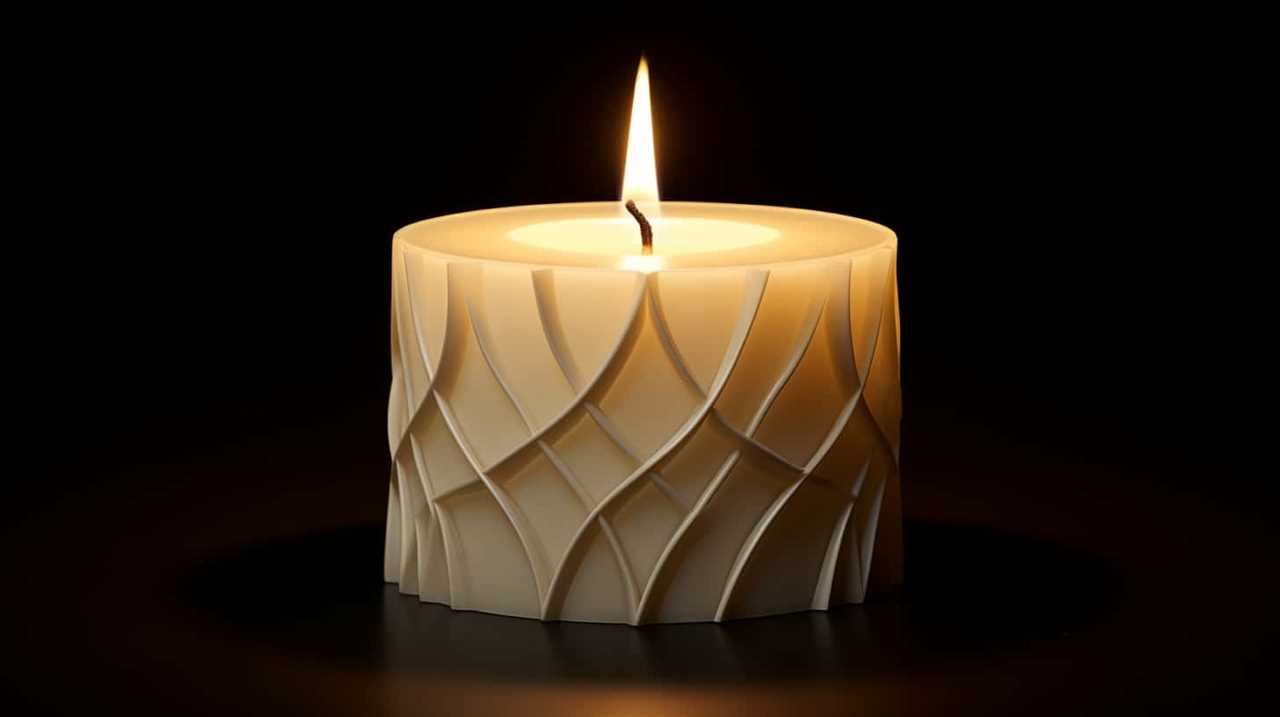Have you ever wondered why a candle turns as black as the night sky without stars? Let us shed light on the reasons behind this intriguing phenomenon.
When we burn a candle, it undergoes a complex chemical process called combustion. The flame dances, fueled by the oxygen in the air, causing the wax to melt and evaporate. As the wax vapor rises, it mixes with the air and ignites, creating a beautiful glow.
However, this magical transformation can sometimes result in the candle emitting soot, which causes it to turn black. Understanding the factors that contribute to this soot formation, such as the type of wick and the temperature of the flame, can help us find ways to prevent it.
So, join us as we unravel the science behind candle blackening and discover tips to keep your candles burning brilliantly without any trace of darkness.

Key Takeaways
- Soot formation in candles is caused by incomplete combustion, where not all carbon is converted to carbon dioxide.
- Factors such as flame temperature, wax type, and additives like fragrances can influence the amount of soot produced by a candle.
- Proper ventilation and airflow help maintain a steady combustion process and reduce the formation of black soot.
- Choosing high-quality materials, including the type of wax and wick, can help prevent excessive soot production and improve air quality.
The Chemistry of Combustion
In the chemistry of combustion, we witness the transformation of a candle’s wax and wick into carbon dioxide and water vapor. Flame chemistry plays a crucial role in this process, as it involves a series of chemical reactions that occur within the flame.
When the candle is lit, the heat causes the wax to melt and be drawn up the wick. As the wax reaches the flame, it vaporizes and undergoes a process called pyrolysis. This is where the chemical bonds in the wax molecules break apart, releasing various volatile compounds.
These compounds then react with oxygen in the air, resulting in the production of carbon dioxide and water vapor. The flame itself provides the necessary heat and energy to sustain these chemical reactions, creating a continuous cycle of combustion.
Role of Oxygen in Candle Burning
As we delve into the role of oxygen in candle burning, we observe how this essential element interacts with the volatile compounds released during the pyrolysis process. Oxygen concentration plays a crucial role in determining the combustion rate of a candle.

Here are five key points to consider:
- Oxygen is necessary for combustion to occur. It combines with the fuel molecules in the candle, releasing heat and light.
- The higher the oxygen concentration in the surrounding air, the faster the candle will burn. This is because more oxygen is available to react with the fuel.
- Conversely, if the oxygen concentration is low, the combustion rate decreases. The flame may become weak and flickering.
- Proper ventilation is essential to maintain an adequate oxygen supply. It ensures a steady combustion rate and prevents the formation of soot.
- Excess oxygen can also affect the candle’s burning characteristics. It may cause the flame to become larger and more unstable.
Understanding the role of oxygen in candle burning allows us to create optimal conditions for a clean and efficient burn.
Impact of Wick Material on Candle Color
When it comes to the color of a candle, the material of the wick plays a significant role. Different wick materials can produce varying amounts of soot, which can affect the overall color of the candle.
The type of wick used can also impact the way the candle burns, which in turn can influence its color.

Wick Material and Soot
Exploring the impact of wick material on candle color, we observe the formation of soot and its connection to the blackening of the candle. Different wick material types can affect the amount and color of soot produced during burning. Here are five key points to consider:
- Cotton wicks: These wicks, made from natural fibers, tend to produce less soot compared to synthetic wicks.
- Zinc-core wicks: These wicks contain a zinc core, which helps reduce the amount of soot produced.
- Paper wicks: Paper wicks have a tendency to produce more soot, resulting in a darker candle color.
- Metal wicks: Metal wicks, such as those made from stainless steel, can produce more soot due to incomplete combustion.
- Wooden wicks: These wicks, often made from sustainably sourced wood, can create a unique aesthetic but may produce more soot.
Understanding the effects of different wick materials on soot production can help create candles that burn cleaner and have a more desirable appearance.
Candle Color Variations
To understand the impact of wick material on candle color, we delve into the variations that arise due to different wick materials.
The type of wick material used in a candle can have a significant influence on the color of the flame it produces. Different wick materials burn at different temperatures, which in turn affects the color of the flame.

For example, a cotton wick tends to burn at a lower temperature, resulting in a yellow flame. On the other hand, a wick made of a blend of cotton and linen may burn at a higher temperature, creating a brighter and whiter flame.
The wick material plays a crucial role in determining the candle’s burning temperature, and consequently, the color of the flame it emits. Understanding these variations can help us choose the appropriate wick material to achieve the desired candle color.
Wick Impact on Burning
In our exploration of candle color variations, we’ve learned that the type of wick material used in a candle has a significant impact on the color of the flame it produces. The wick material selection plays a crucial role in determining the color intensity and brightness of the candle flame. Additionally, adjusting the wick length can also affect the color of the flame.
Here are five key points to consider regarding the wick’s impact on burning:

- Different wick materials, such as cotton, hemp, or wood, can produce varying flame colors.
- Synthetic wicks tend to produce brighter and more vibrant flames compared to natural fiber wicks.
- Longer wicks generally result in larger and hotter flames, which can affect the color intensity.
- Shorter wicks may produce smaller flames with a cooler color tone.
- Proper wick selection and length adjustment are essential in achieving the desired candle flame color.
Understanding the relationship between the wick material and burning can help candle makers create candles with the desired visual appeal and ambiance.
The Influence of Flame Temperature
Flame temperature plays a crucial role in the color and appearance of a candle flame. The temperature of the flame determines the types of combustion products that are produced.
Higher flame temperatures can result in incomplete combustion and the formation of soot, which can make the candle turn black.
Understanding the influence of flame temperature on a candle’s appearance is essential for identifying ways to minimize soot formation and maintain a clean-burning flame.

Flame Color and Soot
We’ve discovered that the color of a flame and the amount of soot produced are directly influenced by the temperature of the flame. Understanding the relationship between flame color and soot production is essential for those interested in serving others by providing clean and efficient lighting sources. Here are some key points to consider:
- Flame color variations: Different elements or chemicals present in a candle can produce different colored flames. For example, a blue flame indicates a high-temperature, clean burn, while a yellow or orange flame suggests incomplete combustion and the presence of soot.
- Effects of fragrance on soot production: Adding fragrance to a candle can affect the flame color and soot production. Some fragrances may contain compounds that increase soot formation, leading to a darker flame and more soot deposition.
- Temperature control: By adjusting the flame temperature, it’s possible to influence the color and amount of soot produced. A well-regulated flame with sufficient oxygen supply can result in a cleaner burn and reduced soot.
- Combustion efficiency: A hotter flame generally indicates better combustion efficiency, resulting in less soot production. Maximizing combustion efficiency can help reduce the amount of soot emitted.
- Importance of clean burning: Minimizing soot production isn’t only beneficial for aesthetic reasons but also for health and environmental concerns. Clean burning candles produce less indoor pollution and contribute to better air quality.
Understanding the relationship between flame color, soot production, and temperature is crucial for those seeking to provide clean and efficient lighting solutions. By controlling the flame temperature and ensuring proper combustion, we can serve others by offering candles that produce minimal soot and contribute to a healthier environment.
Temperature and Combustion Products
As we delve into the influence of flame temperature on a candle’s combustion products, it becomes evident that the heat generated plays a pivotal role in determining the amount of soot produced. The temperature of a candle’s flame is directly related to the combustion byproducts it produces.
When the flame temperature is low, incomplete combustion occurs, leading to higher levels of soot. This can be mitigated by ensuring proper oxygen supply to the flame, allowing for complete combustion and reducing soot formation.

Additionally, the type of wax used in the candle can also affect the flame temperature and, consequently, the amount of soot produced. By selecting candles with lower soot-forming waxes and maintaining an optimal flame temperature, candle soot prevention can be achieved.
This results in cleaner and healthier air quality.
Impact on Candle’s Appearance
The influence of flame temperature on a candle’s appearance can be seen through its impact on the amount of soot produced. When the flame temperature is high, the candle tends to produce more soot, resulting in a darker and dirtier appearance. On the other hand, when the flame temperature is low, the candle produces less soot, leading to a cleaner and more aesthetically pleasing appearance.
This understanding is crucial for candle soot prevention, as maintaining a lower flame temperature can help reduce the amount of soot produced. By doing so, not only can the candle’s appearance be preserved, but the impact on indoor air quality can also be minimized. Taking measures to prevent excessive soot production can contribute to a healthier and cleaner environment for everyone.

- Higher flame temperature leads to more soot production
- Lower flame temperature results in less soot production
- Candle appearance is darker and dirtier with higher flame temperature
- Candle appearance is cleaner and more aesthetically pleasing with lower flame temperature
- Maintaining a lower flame temperature helps preserve candle appearance and reduce indoor air pollution.
Understanding Soot Formation
To understand soot formation, we observe the chemical reactions that occur when a candle burns.
When a candle is lit, the heat melts the wax, which is then drawn up the wick through capillary action.
Once the liquid wax reaches the flame, it vaporizes and undergoes combustion.
The combustion reaction breaks down the hydrocarbon molecules in the wax, releasing energy in the form of heat and light.

However, not all the carbon in the wax gets converted to carbon dioxide.
Some of it remains as tiny particles called soot.
Soot particles are black and can be harmful to human health when inhaled.
To prevent candle soot formation and minimize its effects on health, it’s important to choose candles made from high-quality materials and to ensure proper ventilation in the room.

Transitioning into the next section, we’ll now examine the role of impurities in the formation of candle soot.
Examining the Role of Impurities
When examining the role of impurities in candle soot formation, we find that they contribute significantly to the blackening of the candle flame. Impurities in the wax can come from various sources and can greatly impact the cleanliness of the burning process.
Here are five key points to consider:
- The type and quality of wax used in a candle can determine the presence of impurities.
- Additives like colorants or fragrances may contain impurities that can contribute to soot formation.
- Poor filtration during the manufacturing process can result in impurities being present in the wax.
- Environmental factors, such as dust or pollutants in the air, can also introduce impurities into the burning process.
- Regular maintenance, such as trimming the wick and keeping the candle away from drafts, can help reduce soot formation caused by impurities.
Factors Affecting Candle Smoke
When considering the factors that affect candle smoke, two important points come to mind: air quality and the type of wick used.

Poor air quality, such as a lack of ventilation or an excessive amount of dust particles, can contribute to the production of more soot and black smoke.
Additionally, the type of wick, whether it’s made of cotton, hemp, or other materials, can also impact the amount and color of smoke emitted by the candle.
Air Quality and Soot
We noticed that the candle’s smoke darkened when we lit it, and we wondered what factors contributed to this phenomenon. The quality of the air and the presence of soot play a significant role in the smoke produced by candles. Here are five factors that affect air quality and contribute to the formation of candle soot:
- Indoor air pollution: Burning candles can release harmful pollutants into the air, such as volatile organic compounds (VOCs) and particulate matter, which can negatively impact indoor air quality.
- Candle composition: The materials used in the candle, such as the type of wax and additives, can influence the amount of soot produced.
- Wick length: A longer wick can lead to more incomplete combustion and increased soot production.
- Airflow: Poor ventilation or drafts can disturb the flame and cause the candle to produce more soot.
- Burning conditions: Factors like burning time and temperature can affect the amount of soot produced.
Understanding these factors is crucial for maintaining good air quality and protecting respiratory health.

Now, let’s delve into the next section to explore the different types of wicks.
Types of Wicks
One important factor that affects the smoke produced by candles is the type of wicks used. The materials and construction of the wick play a significant role in determining the amount of smoke generated during candle burning. Different wick materials, such as cotton, hemp, or paper, can affect the burning characteristics of the candle and the amount of smoke produced. Wick construction, including the size, shape, and thickness, also influences the burning process and smoke emission. To illustrate the impact of wick types on candle smoke, consider the following table:
| Wick Material | Wick Construction |
|---|---|
| Cotton | Braided |
| Hemp | Twisted |
| Paper | Flat |
Understanding the relationship between wick materials and construction can help candle enthusiasts choose the right wick for their desired burn characteristics. Now, let’s delve into the role of airflow in candle burning.
Subsequent Section: ‘Role of Airflow in Candle Burning’
Role of Airflow in Candle Burning
As we explore the reasons behind a candle turning black, it becomes evident that the role of airflow plays a significant role in the process. The way air flows around a burning candle affects its burning speed and can contribute to the production of soot.

Here are five key points to consider:
- Airflow helps fuel the flame by providing oxygen for the combustion process.
- A steady and controlled airflow promotes efficient burning and reduces the amount of soot produced.
- However, excessive airflow can cause the flame to flicker and become unstable, leading to an incomplete combustion process and the formation of black smoke.
- Drafts or gusts of wind can disrupt the airflow around the candle, causing it to burn unevenly and produce more soot.
- Proper ventilation in a room can help maintain a steady airflow around the candle, reducing the likelihood of blackening.
Understanding the role of airflow in candle burning can help us optimize the burning conditions and minimize the blackening effect, ensuring a cleaner and more enjoyable candle experience for all.
The Science Behind Candle Blackening
To understand the science behind candle blackening, let’s delve into the chemical reactions occurring during its combustion.
When a candle is lit, the heat from the flame melts the wax near the wick. This liquid wax is then drawn up the wick, where it vaporizes and reacts with oxygen in the air. The main products of this combustion process are carbon dioxide and water vapor.

However, incomplete combustion can occur, particularly when the flame isn’t getting enough oxygen. In these cases, carbon particles are formed, which are then released into the air as soot.
This black soot not only mars the appearance of the candle but can also contribute to air pollution. To prevent candle soot and reduce its impact on air quality, it’s important to ensure proper airflow around the flame and maintain a clean burning candle.
Tips for Preventing Candle Soot
Let’s discuss some ways we can prevent candle soot. Here are five tips to help you reduce candle smoke and keep your candles clean:
- Trim the wick: Before lighting the candle, make sure to trim the wick to about ¼ inch. This will prevent excessive smoke and soot.
- Choose quality candles: Opt for candles made from high-quality materials, such as soy or beeswax. These tend to produce less soot compared to cheaper alternatives.
- Avoid drafts: Place your candles away from open windows or fans, as drafts can cause uneven burning and increase soot production.
- Use candle accessories: Consider using a candle snuffer or lid to extinguish the flame instead of blowing it out. This helps prevent excessive smoke and soot.
- Keep the candle clean: Regularly clean the candle surface to remove any soot buildup. A gentle wipe with a soft cloth or paper towel should do the trick.
Frequently Asked Questions
Can Using Scented Candles Affect the Amount of Soot Produced?
Using scented candles can affect the amount of soot produced. Fragrances in candles contain chemicals that can release harmful particles when burned. Breathing in soot can pose health risks and negatively impact air quality.

How Does the Size of the Candle Affect the Amount of Black Smoke Produced?
The size of a candle can impact the amount of black smoke produced. Larger candles tend to burn longer, resulting in a higher flame height, which can increase the production of black smoke.
Can the Type of Wax Used in a Candle Impact the Amount of Soot It Produces?
The type of wax used in a candle can impact the amount of soot it produces, which has environmental and health effects. Understanding these impacts can help us make informed choices for a cleaner and healthier environment.
Does the Color of the Candle Affect the Amount of Black Smoke Produced?
The color of a candle can indeed influence the amount of black smoke it produces. A darker-colored candle tends to produce more soot, while a lighter-colored candle produces less.
Can Burning a Candle in a Drafty Area Increase the Amount of Soot It Produces?
Burning a candle in a drafty area can increase soot production, which may pose potential health risks if inhaled. To reduce soot, try using candles made of natural materials, trimming the wick, and placing the candle away from drafts.

Conclusion
In conclusion, understanding the science behind why candles turn black can help us prevent unwanted soot and enjoy cleaner burning candles.
Did you know that the temperature of the flame plays a significant role in candle color? It’s fascinating to learn that higher flame temperatures can lead to more soot formation.
By choosing the right wick material and ensuring proper airflow, we can minimize candle smoke and keep our candles looking beautiful.
















